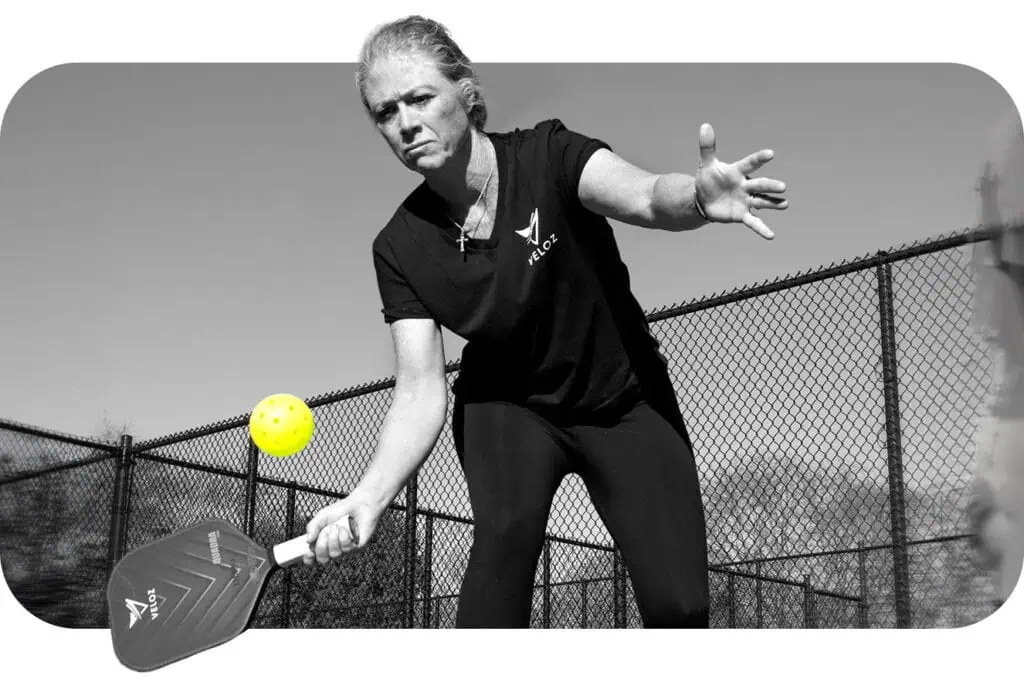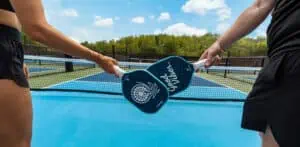Pickleball
How to Master the Pickleball Dink Shot: Effective Techniques and Tips

Pickleball is not just a game; it’s a thrilling mix of strategy, agility, and precision that keeps players on their toes. One of the most critical skills to develop in this sport is the dink shot—a soft, controlled maneuver that can change the flow of play. Many players often underestimate the power of a well-executed dink, but it can be your secret weapon to outsmart opponents and control the pace of the game. Whether you’re new to the court or looking to sharpen your skills, understanding how to master this technique is essential. In this article, we will explore effective methods to refine your dink shot and elevate your competitive edge—because in pickleball, every little shot counts!
To master the pickleball dink shot, focus on keeping your paddle head above your wrist for more consistent execution, strike the ball linearly across your body for offensive cross-court dinks, and maintain a slight closing of the paddle face during backhand shots to reduce pop-ups. Additionally, bending your knees while dinking will enhance your stability and control, allowing for greater precision in your shots.
What is the Pickleball Dink Shot?
The dink shot is a soft, controlled shot executed from the non-volley zone, also known as the kitchen, aimed to drop gently into the opponent’s non-volley area. When performed correctly, its trajectory is often a graceful arc that lands just over the net and ideally reaches a height of three to five feet. The beauty of this shot lies not only in its finesse but also in its purpose; it forces your opponents to hit upward, making executing an aggressive return challenging for them.
Mastering the dink shot can be a game-changer because it allows players to dictate the pace of play. Think of each dink as a strategic move—much like chess pieces on a board—that holds potential for manipulating future shots. The aim isn’t solely about making a point; it’s about constantly putting yourself in the best position for your next move. In fact, studies have shown that incorporating dinks into gameplay can significantly enhance one’s chances of winning at the net by around 60%.
This reflectively illustrates that it’s not just about aggressive gameplay; sometimes, patience and precision are key aspects of strategy.
It’s interesting to note how higher-level players leverage this technique. According to data from the USA Pickleball Association, nearly 40% of rallies at advanced levels involve dink shots, demonstrating their crucial role in competitive play.
But what exactly makes a successful dink shot? Several factors contribute: consistency, angles, and intention behind every swing. Keeping the paddle head above the wrist promotes better control and minimizes unpredictable outcomes. Furthermore, striking the ball linearly rather than adopting a low-to-high motion enhances accuracy, particularly when attempting offensive cross-court dinks.
Understanding the nuances of the pickleball dink shot amplifies your effectiveness on the court while shaping your overall game strategy. By focusing on these elements, you’re not just learning how to execute dinks; you’re embracing a tactical approach that positions you favorably against your opponents.
Now that we have established what makes for an effective dink shot, let’s explore specific techniques that will further refine this crucial aspect of your pickleball gameplay.
Essential Dinking Techniques
Mastering the dink shot requires sound technique to ensure consistency and precision. One of the fundamental aspects every player should focus on is keeping the paddle head above the wrist. This simple adjustment can transform your performance significantly. By maintaining this position, you’re not just enhancing your shot consistency; you are also reducing reliance on wrist actions, which can often lead to erratic shots. Imagine you’re in a heated match; every detail counts. Pro players like Ben Johns emphasize this method for a reason; it provides a stable foundation for all your dinking shots and boosts your confidence.
Now that we’ve highlighted the paddle position, it’s important to consider how we swing.
Execute a Linear Swing
Striking the ball with a linear motion across your body is another crucial technique. This approach is vital for effective offensive cross-court dinks because it allows for more precise control over where the ball lands. Instead of relying on an upward swing—which can be reminiscent of tennis and yield unpredictable results—think of your swing as if you were drawing a straight line across your torso as you connect with the ball. Not only does this enhance accuracy, but it also helps mislead your opponent regarding your intended direction. Your opponents will react after seeing where they think you’re aiming, only to find out you’ve gone a different way!
Speaking of positioning, let’s talk about another technique that plays a significant role in mastering your shots.
Bend Your Knees
One often overlooked aspect of effective dinking involves bending your knees during play. When you bend your knees, you lower your center of gravity, which enhances stability and control over your shots. This added stability improves shot accuracy; when you’re grounded, you’re less likely to misfire or lose balance as you execute those precise dinks. Furthermore, this stance optimizes performance and acts as a preventive measure against injuries, particularly during fast-paced rallies that require quick lateral movements.
Implementing these techniques takes practice and patience. As you engage in consistent drills with these principles in mind, you’ll notice improvements in your dinking skills over time. Setting aside dedicated practice sessions specifically focused on experimenting with different paddle positions and swings while maintaining proper posture will enhance your overall game. By reflecting on what works best for you during each session, you can tailor your practices toward these fundamentals, transforming how you approach matches overall.
Drills for Precision and Control
One effective way to improve your dinking skills is through structured drills that allow you to focus on precision and control. For instance, the Partner Dink Rally is an excellent exercise for both beginners and seasoned players. By standing at the non-volley line with a partner, you engage in a controlled rally that emphasizes dinking—the goal here isn’t just to hit the ball back and forth but to maintain a rhythmic flow while keeping the ball within the confines of the non-volley zone.
It’s amazing how quickly this drill can enhance your feel for the ball and build your confidence in making accurate shots.
As you get comfortable with the Partner Dink Rally, stepping up your game involves more dynamic drills that challenge your adaptability on the court.
The Triangle Drill
One of those drills is known as the Triangle Drill. To set it up, you’ll need three cones arranged in a triangle: one positioned at the net and two others at opposite baseline corners. This setup forces you to move strategically while honing your dinking angle. You’ll start by dinking from one baseline cone towards the net cone before transitioning to the opposite baseline cone.
The beauty of this practice lies in its requirement to adjust angles with every shot while also refining your footwork—both essential skills in real-game scenarios.
It’s worth considering that every adept player knows agility alone won’t win games; mastering control over your shots is just as critical.
Alongside physical skill, these drills emphasize intention. Each shot should have purpose, whether you’re aiming for precision or setting up your opponent for a successful play. The quote from Tyson McGuffin encapsulates this perfectly: “Consistent practice, backed by drills like these, can substantially improve your game.” This isn’t just about repetition; it’s about engaging mindfully with each stroke to develop those all-important habits over time.
Have you thought about how many opportunities you might be missing simply because your technique isn’t quite where you want it? Regularly integrating such drills into your practice routine not only prepares you for competitive matches but also enriches your overall experience.
Building upon these foundational skills will lead us into exploring strategies that enhance not only your offensive capabilities but also your defensive gameplay on the pickleball court.
Offensive and Defensive Dinking Strategies
Knowing when to switch between offensive and defensive strategies can make the difference between winning and losing a match. Offensive dinking is where the magic happens, allowing you to capitalize on your opponent’s weaknesses while creating opportunities for easy points. This approach involves targeting areas on the court that challenge your opponent’s strengths—primarily their backhand or forcing them into awkward lateral movements. By pushing your opponents outside of their comfort zones, you heighten the chances they’ll make an error or create an opening for you to finish the point effectively.
Offensive Dinking
An effective offensive dink requires precision and intention. Consider directing your shot toward the weaker side of your opponent; studies show that approximately 60% of players exhibit weaker backhands. By constantly applying pressure in this manner, you can force mistakes. The key is to maintain a firm paddle face while executing these shots, which provides better control over where the ball lands and minimizes the risk of pop-ups.
Simply put, successful offensive dinking translates to fewer errors for you and increased discomfort for your rival.
As we transition to defensive dinking, it’s important to recognize that not every situation calls for aggression. Defensive dinking is all about buying yourself time and resetting the rally when under pressure. If you’re caught off guard, perhaps pinned at the baseline, a high, defensive dink can disrupt your opponent’s rhythm and allow you to regroup. The goal here is maintaining the rally while steering clear of overly aggressive shots that might lead to unforced errors.
Defensive Dinking
Defensive dinking helps neutralize the game, allowing players to regain control without sacrificing their standing on the court. A well-executed deep dink prompts your opponent to react, buying you critical seconds to reposition strategically. It often requires bending your knees for stability, ensuring precise placement as you aim for areas that will revert pressure back onto them.
Both styles serve distinct purposes; understanding when to employ each can significantly improve your gameplay. It’s crucial to adapt these strategies based on real-time conditions and how your opponent reacts during exchanges. By incorporating intentionality into every shot—assessing whether you’re dictating play or merely defending—you’re likely to see a marked improvement in both your confidence and effectiveness on the court.
By mastering these techniques, you’ll be well-prepared to implement them seamlessly into your broader match strategies, setting yourself up for greater success in competitive play.
Integrating the Dink Shot into Your Play
The effective integration of the dink shot into your gameplay requires not just skill but also a strong sense of strategic thinking and adaptability. It’s not merely about executing the shot; it’s about weaving it seamlessly into your broader strategy. By honing this skill, you’ll enhance your individual performance while disrupting your opponent’s rhythm on the court.
Timing Your Dinks
One of the most critical aspects of mastering the dink shot lies in timing. You must develop a keen awareness of your opponent’s tendencies and weaknesses; this knowledge allows you to make your dinks both unpredictable and effective. For example, if you notice that an opponent tends to struggle with low, soft shots—often popping them up instead—you can capitalize on this weakness by incorporating dinks into your rallies strategically. This will force them to adapt to challenging positions, thereby putting you in control of the game.
“In pickleball, how and when you deploy a shot can be just as important as the shot itself.”
As you become more proficient at timing your shots, it’s equally important to focus on precision in execution.
Mix Up Your Shots
When integrating dinks into your play style, don’t allow yourself to become predictable. Consistency is essential, but mixing up your shots keeps your opponents off-balance. Alternate between dinks and faster shots; this dynamic approach maintains pressure while ensuring that they never settle into a comfortable routine against you. By maintaining a controlled yet varied arsenal of shots, you create opportunities for offensive plays without sacrificing defensive stability.
A well-timed dink can shift momentum quickly; imagine transitioning from a gentle dink to a vigorous smash right after drawing your opponent too close to the net. This kind of strategic variation will surprise them and create openings that propel you towards victory.
The key takeaway here is intentionality. Each shot should have a purpose, whether to set up for an aggressive follow-up or simply to extend the rally smartly.
Crafting layers within your game plan is essential for maximizing both your strengths and exploiting your opponents’ weaknesses. As we move forward, we’ll examine how consistent practice can build confidence and enhance these vital skills.
Boosting Confidence with Consistent Practice
Confidence stems from repetitive success and a practiced hand, which is why routine practice is vital for mastering the dink shot. To develop this essential skill, it’s important to set aside dedicated time—daily or weekly—for drills specifically aimed at improving your dinking technique. This doesn’t have to be tedious; mixing up your routines can keep things fresh and engaging. For instance, you might try solo wall dinks one day, followed by partner shadow drills the next. If you’re looking to elevate your game, consider joining a pickleball league or attending camps available through VibeGetaways.
Routine Practice
Here are some engaging practice routines that help maintain motivation while honing your skills:
- Solo Wall Dinks: Stand a few feet from a solid wall and practice your dinks against it. Focus on controlling the height and angle of each shot. This exercise helps with precision and allows for immediate self-evaluation.
- Partner Shadow Drills: Team up with a friend for drills where you mimic each other’s movements without the ball initially. This solidifies footwork patterns and positioning that will translate into actual gameplay.
- Simulated Game Scenarios: Set up drills replicating in-game situations, such as volleys coming from different angles or unexpected high-paced exchanges. This type of practice enhances your ability to perform under pressure.
As you consistently engage in these routines, tracking your progress becomes essential for fostering confidence in your game.
Track Your Progress
Keeping a journal to track your practice sessions provides insight into areas needing improvement while allowing you to celebrate small victories. Each entry should note the number of successful dinks, what felt comfortable, and what challenges arose during each session. Noticing improvement—even if gradual—reinforces positive habits and builds self-assurance in your abilities as a player.
“Every great player started as a novice; it’s the consistency of effort that separates champions from the rest.”
Ultimately, merging intention with routine—through regular practice rituals or documenting progress—creates a more confident player ready to face difficult opponents on the court. By embracing both elements through engagement and reflection, you sharpen not just your skills but also elevate your game fundamentally.
For any questions or personalized assistance in booking your all-inclusive Pickleball vacation, contact us at VibeGetaways or call us at 262-891-4768.
More Articles
Pickleball: The Perfect Family Vacation Activity for Outdoor Fun and Bonding
Looking for a fun way to get the whole family outside and active on your next vacation? Pickleball might be…
Read MorePickleball History and Popularity: From Backyard Roots to a Global Sport
Pickleball started as a simple way for friends and family to have fun together, but today it’s become much more…
Read MoreVacation Planning Tips & Tricks: Your Ultimate Holiday Checklist for 2025
Planning a vacation might seem as simple as booking a flight and packing a bag, but anyone who’s ever felt…
Read More5 Secrets to Stress-Free Vacation Planning: The Ultimate Guide to Easy Travel
Planning a vacation should be exciting, not stressful, but all too often it feels like a juggling act, with flights,…
Read More


